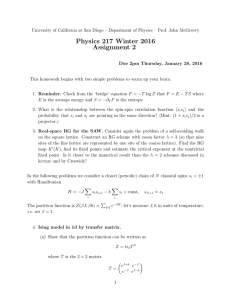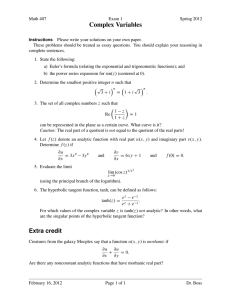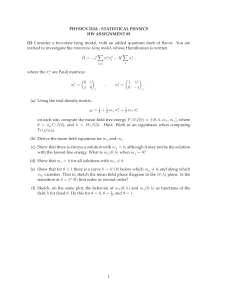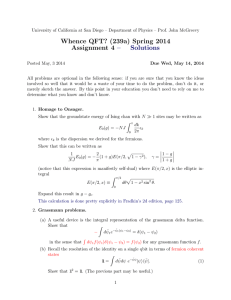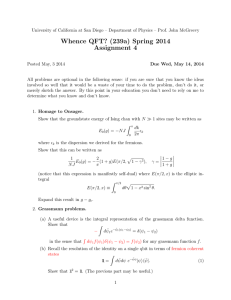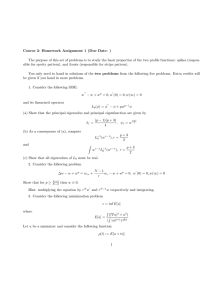VI.D Self–Duality in the Two ...
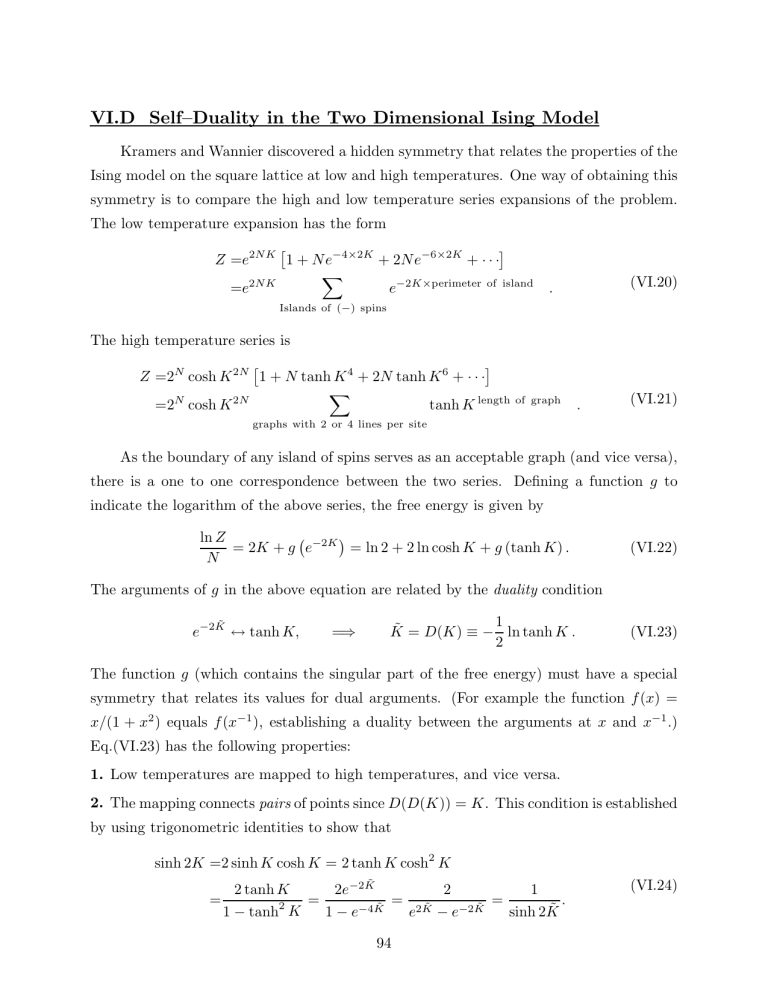
VI.D
Self–Duality in the Two Dimensional Ising Model
Kramers and Wannier discovered a hidden symmetry that relates the properties of the
Ising model on the square lattice at low and high temperatures. One way of obtaining this symmetry is to compare the high and low temperature series expansions of the problem.
The low temperature expansion has the form
Z = e
2 NK � 1 + N e
− 4 × 2 K
+ 2 N e
− 6 × 2 K
+ · · · �
= e
2 NK �
Islands of ( − ) spins e
− 2 K × perimeter of island
.
(VI .
20)
The high temperature series is
Z =2
N cosh K
2 N � 1 + N tanh K
4
+ 2 N tanh K
6
+ · · · �
=2
N cosh K
2 N � graphs with 2 or 4 lines per site tanh K length of graph
.
(VI .
21)
As the boundary of any island of spins serves as an acceptable graph (and vice versa), there is a one to one correspondence between the two series. Defining a function g to indicate the logarithm of the above series, the free energy is given by ln Z
� = 2 K + g e − 2 K � = ln 2 + 2 ln cosh K + g (tanh K ) .
N
(VI .
22)
The arguments of g in the above equation are related by the duality condition e
− 2 K ↔ tanh K, = ⇒
˜
= D ( K ) ≡ −
1
2 ln tanh K .
(VI .
23)
The function g (which contains the singular part of the free energy) must have a special symmetry that relates its values for dual arguments. (For example the function f ( x ) = x/ (1 + x 2 ) equals f ( x − 1 ), establishing a duality between the arguments at x and x − 1 .)
Eq.(VI.23) has the following properties:
1.
Low temperatures are mapped to high temperatures, and vice versa.
2.
The mapping connects pairs of points since D ( D ( K )) = K . This condition is established by using trigonometric identities to show that sinh 2 K =2 sinh K cosh K = 2 tanh K cosh 2 K
=
2 tanh K
1 − tanh
2
K
2 e − 2 K
=
1 − e − 4 K
=
2 e 2 K − e − 2 K
=
1 sinh 2 K
.
94
(VI .
24)
Hence, the dual interactions are symmetrically related by sinh 2 K · sinh 2 K .
(VI .
25)
3.
If the function g ( K ) is singular at a point K c
, it must also be singular at K c
. Since the free energy is expected to be analytic everywhere except at the transition, the critical model must be self dual . At the self dual point e − 2 K c = tanh K c
=
1 − e − 2 K c
1 + e − 2 K c
, which leads to the quadratic equation, e
− 4 K c + 2 e
− K c − 1 = 0 , = ⇒ e
− 2 K c = − 1 ±
√
2 .
Only the positive solution is acceptable, and
K c
= −
1
2 ln
�
√
�
2 − 1 =
1
2 ln
�
√
�
2 + 1 = 0 .
441 · · · .
(VI .
26)
4.
As will be explored in the next section and problem sets, it is possible to obtain dual partners for many other spin systems, such as the Potts model, the XY model, etc. While such mappings place useful constraints on the shape of phase boundaries, they generally provide no information on critical exponents. (The self–duality of many two dimensional models does restrict the ratio of critical amplitudes to unity.)
VI.E
Dual of the Three Dimensional Ising model
We can attempt to follow the same procedure to search for the dual of the Ising model on a simple cubic lattice. The low temperature series is
Z = e 3 NK � 1 + N e − 2 K × 6 + 3 N e − 2 K × 10 + · · · �
= e 3 NK � e − 2 K × area of island
′ s boundary .
Islands of ( − ) spins
(VI .
27)
By contrast, the high temperature series takes the form
Z =2
N cosh K
3 N � 1 + 3 N tanh K
4
+ 18 N tanh K
6
+ · · · �
=2
N cosh K
3 N � graphs with 2 , 4 , or 6 lines per site tanh K number of lines
.
95
(VI .
28)
Clearly the two sums are different, and the 3 d Ising model is not dual to itself. Is there any other Hamiltonian whose high temperature series reproduces the low temperature terms for the 3 d Ising model? To construct such a model note that:
1.
The low temperature terms have the form e − 2 K × area , and the area is the sum of faces covered on the cubic lattice. Thus plaquettes must replace bonds as the building blocks of the required high temperature series.
2.
How should these plaquettes be joined together? The number of bonds next to a site can be anywhere from 3 to 12 while there are only two or four faces adjacent to each bond.
This suggests ‘glueing’ the plaquettes together by placing spins ˜ i
= ± 1, on the bonds of the lattice.
3.
By analogy to the Ising model, we can construct a partition function,
� �
{ σ i
P
= ± 1 } plaquettes P
(1 + tanh σ 1
P
2
P
3
P
4
P
) ∝
�
˜ e
�
P
˜
1
P
˜
2
P
{ σ i
}
3
P
˜
4
P , (VI .
29) i
P are used to denote the 4 dual spins around each plaquette, and K eq.(VI.23). This partition function describes a system dual to the original 3 d Ising model, in the sense of reproducing its low temperature series. (Some reflection demonstrates that the low temperature expansion of the above partition function reproduces the high temperature expansion of the Ising model.)
Eq.(VI.29) describes a Z
2 lattice gauge theory . The general rules for constructing such theories in all dimensions are: (i) Place Ising spins σ ˜ i
= ± 1, on the bonds of the lattice. (ii) The Hamiltonian is − β H = K � all plaquettes
� i
P
. In addition to the global
Ising symmetry, ˜ i
→ − σ ˜ i
, the Hamiltonian has a local (gauge) symmetry. To observe this symmetry, select any site and change the signs of spins on all bonds emanating from it. As in each of the faces adjacent to the chosen site two bond spins change sign, their product, and hence the overall energy, is not changed.
There is a rigorous proof ( Elitzur’s theorem ) that there can be no spontaneous sym metry breaking for Hamiltonians with a local symmetry. The essence of the proof is that even in the presence of a symmetry breaking field h , the energy cost of flipping a spin is finite (6 h for the gauge theory on the cubic lattice). Hence the expectation value of spin changes continuously as h → 0. (By contrast, the energy cost of a spin flip in the Ising model grows as N h .) This theorem presents us with the following paradox: Since the three dimensional Ising model undergoes a phase transition, there must be a singularity in its
96
partition function, and also that of its dual. How can there be a singularity in the parti tion function of the three dimensional gauge theory if it does not undergo a spontaneous symmetry breaking?
To resolve this contradiction, Wegner suggested the possibility of a phase transition without a local order parameter. The two phases are then distinguished by the asymptotic behavior of correlation functions. The appropriate correlation function must be invariant under the local gauge transformation. For example, the Wilson loop is constructed by selecting a closed path of bonds S , on the lattice and examining
C
S
= h Product of ˜ around the loop i =
�
�
˜ i i ∈ S
�
.
(VI .
30)
As any gauge transformation changes the signs of two bonds on the loop, their product is unaffected and C
S is gauge invariant. Since the Hamiltonian encourages spins of the same sign, this expectation value is always positive. Let us examine the asymptotic dependence of C
S on the shape of the loop at high and low temperatures. In a high temperature expansion, the correlation function is obtained as a sum of all graphs constructed from plaquettes with S as a boundary. Each plaquette contributes a factor of tanh K
1
C
S
=
Z
� �
{ σ i
} i ∈ S
σ ˜ i e
K
�
P
˜
1
P
σ
2
P
˜
3
P
˜
4
P
�
= tanh
˜
�
Area of S
�
1 + O
� tanh K
2
��
≈ exp
� �
− f tanh
˜
� �
× Area of S .
(VI .
31)
The low temperature expansion starts with the lowest energy configuration. There are in fact N
G
= 2 N such ground states related by gauge transformations. The N
P plaquette interactions are satisfied in the ground states, and excitations involve creating unsatisfied plaquettes. Since C
S is gauge independent, it is sufficient to look at one of the ground states, e.g. the one with ˜ i
= +1 for all i . Flipping the sign of any of the 3 N bonds creates an excitation of energy 8 K of bonds on the perimeter of the Wilson loop by P
S
, we obtain
C
S
=
N
N
G
G
· e
P
�
1 + (3 N − P
S
) e − 2 K × 4 (+1) + ( − 1) P
S e − 2 K × 4 + · · ·
� e
P
�
1 + 3 N e − 2 ˜ × 4 + · · ·
�
=1 − 2 P
S e − 8 K
�
+ · · · ≈ exp − 2 e − 8 K P
S
�
+ · · · .
(VI .
32)
97
The asymptotic decay of C
S is thus different at high and low temperatures. At high temperatures, the decay is controlled by the area of the loop, while at low temperatures it depends on its length . The phase transition marks the change from one type of decay to the other, and by duality has the same singularities in free energy as the Ising model.
The prototype of gauge theories in physics is quantum electrodynamics (QED), with the action
�
S = d
�
4 x
¯ � − i / e / m � ψ +
1
4
( ∂
µ
A
ν
− ∂
ν
A
µ
)
2
�
.
(VI .
33)
The spinor ψ is the Dirac field for the electron, and the 4–vector A describes the electro magnetic potential. The phase of ψ is not observable, and the action is invariant under the gauge symmetry ψ 7→ e ieφ ψ , and A
µ
7→ A
µ
− ∂
µ
φ , for any φ ( x ). The Z
2 lattice gauge theory can be regarded as the Ising analog of QED with the bond spins playing the role of the electromagnetic field. We can introduce a ‘matter’ field by placing spins s i
= ± 1, on the sites of the lattice. The two fields are coupled by the Hamiltonian,
− β H = J
� s i h i,j i ij s j
+ K
�
P
1
P
2
P
3
P
4
P
, (VI .
34) where ˜ ij is the spin on the bond joining i and j . The Hamiltonian has the gauge symmetry s i
7→ ( − 1) s i
, and ˜ i,µ
7→ − σ i,µ
, for all bonds emanating from any site i .
Regarding one of the lattice directions as time, a Wilson loop is obtained by creating two particles at a distance x , propagating them for a time t , and then removing them. The probability of such an event is roughly given by C s
∼ e − U ( x ) t , where U ( x ) is the interaction between the two particles. In the high temperature phase, C
S decays with the area of the loop, suggesting U ( x ) t = f (tanh K | x | t . The resulting potential U ( x ) = f (tanh
˜ ) | x | , is like a string that connects the particles together. This is also the potential that describes the confinement of quarks at large distances in quantum chromodynamics. The decay with the length of the loop at low temperatures implies U ( x ) t ≈ g ( e − 8 K )( | x | + t ). For t ≫ | x | the potential is a constant and the force vanishes. (This asymptotic freedom describes the behavior of quarks at short distances.) The phase transition implies a change in the nature of interactions between particles mediated by the gauge field.
98
MIT OpenCourseWare http://ocw.mit.edu
8.334
Statistical Mechanics II: Statistical Physics of Fields
Spring 201 4
For information about citing these materials or our Terms of Use, visit: http://ocw.mit.edu/terms .

